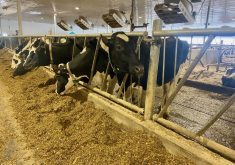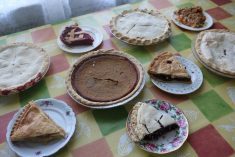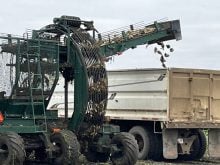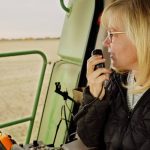TEAM Resources are honored and humbled to have been selected by The Western Producer to continue the traditions that Emmie Oddie initiated in her column, “I’d Like To Know.” Emmie is a special friend and mentor to the four of us. In future columns, we plan to share how Emmie has influenced each of our lives as a friend, teacher, fellow home economist and women’s institute member.
To begin our column, we’d like to introduce ourselves. We are Alma Copeland, Betty Ann Deobald, Jodie Mirosovsky and Barb Sanderson. All of us are home economists who live in and around Rosetown, Sask. Three years ago, we started a writing and adult education business called TEAM Resources. “TEAM” stands for “Time, Talents, Energy, Attitude and Money”, the resources that all individuals have. How each person decides to use and manage these resources affects his or her quality of life and satisfaction with life.
Read Also

Accurate accounting, inventory records are important
Maintaining detailed accounting and inventory records is not just a best practice; it’s a critical component of financial health, operational efficiency and compliance with programs like AgriStability.
With the adult members of many families working outside the home, the personal, family and farm decision-making has become more difficult. This has increased the need to realistically set individual and family goals and to identify priorities. The management of time, energy and money reflects our economist training. But we, as home economists, recognize the family as the basic and most important unit of society, and the role of parenting as the most important job any individual may have.
Just as Emmie did, we welcome your queries to answer, experiences to learn from and ideas to share. Send your letters to The Western Producer, c/o TEAM Resources or How Do You Manage?, Box 2500, Saskatoon, Sask., S7K 2C4.
Managing in a blizzard
The resourcefulness of many individuals was tested during the December blizzards that swept across the Prairies. We would like to share a couple of stories from our area.
In Rosetown, with no rooms left in the local inns, the town opened the Civic Centre to stranded travelers. The gymnastic club’s mats were used as mattresses, service clubs brought blankets, and a local restaurant supplied food. The regional college office made available a television and VCR. About 40 people were sheltered during the storm.
Just north of Rosetown, 19 travellers were stopped because of a snowdrift across the highway. The first car to hit the drift carried Jean Wiens and Sheri Taylor, Midwest District Health employees, travelling from Biggar in the blinding storm. Realizing they had to get the car out or risk being hit by another vehicle, they shoveled and pushed the car to the side of the road.
Fortunately, they had a cellular phone. Jean had also kept track of the kilometres travelled from a local landmark so she was able to identify approximately where they were. The health office phoned the RM to identify the nearest farmer, who was immediately contacted.
Living on the highway, Cameron and Susan Stanek are accustomed to assisting travellers. When the call came to say that Jean and Sheri were stuck near their farm, Cam was able to call them on their car phone to reassure them he knew where they were, and that he would get out to them as soon as the storm let up.
Jean and Sheri had gas to keep the car warm enough but there were no extra blankets, clothes or food in the car. During the four hours that they sat there, they could see nothing except occasionally a tree off to the side of the road. Later in the afternoon, a semitrailer passed, narrowly missing them, and became stuck in the drift. Then a second semi passed and drove into the ditch to miss the first semi.
About 4 o’clock, Cam realized that he had to do something. The storm was so thick that his previous attempts had failed. His solution was a roll of baler twine. He tied one end to a tree near the house and headed to the highway. He first discovered the semis and then the other cars, all stranded just in front of their yard.
During the evening, 19 people found their way to Cam and Susan’s. Some drivers had picked up passengers from other stranded cars along the highway and kept going until the drift stopped them.
The next question for Susan and Cam was how to feed and shelter them all. Being in the cattle business, Susan is used to unexpected guests. But they had been away at Agribition and had not shopped for two weeks.
The resourceful Susan created a hot feast of sweet and sour meatballs, rice, vegetables, buns, salad and lots of hot coffee for her stranded guests. Breakfast was toasted hot dog buns, home-made jams and coffee.
During the evening Cam pulled out the semis, cleared the highway of snow and moved all the cars to his heated shop to thaw out. Those who received Susan and Cam’s shelter and hospitality have expressed their gratitude through letters, phone calls, gifts and sharing of this wonderful story of famous prairie hospitality.
The message learned by all is to be prepared by carrying extra clothes and survival equipment such as emergency heat and food.
Emergency clothing kit:
- Extra parka and warm pants.
- Wool gloves inside a pair of mitts.
- Warm hat or toque and heavy scarf.
- Two or more pairs of wool or
cotton socks.
- Heavy winter or snowmobile boots.
- Emergency blankets or sleeping bags.
Emergency survival kit
- Heat Pack stored in metal tin A, plus several candles, cooking fuel or canned heat, punch-type can opener, to make holes at the bottom of the heat tin to allow air in and matches, preferably wooden.
- Food pack stored in metal tin B (food for two or three people for 48 hours), plus plastic cups and spoons, tea bags, packages of instant coffee and hot chocolate, six sugar packs, four instant soup mixes, and high energy food such as sesame seed bars, granola bars or dried fruit.
- You can melt snow in tin B over the heat source in tin A. Be sure a window is open slightly on both sides of the vehicle when heat source is burning.
First aid kit
Every vehicle should also carry a first aid kit and a winter motoring kit that includes:
- Window scraper and brush.
- Windshield washer antifreeze.
- Gas-line antifreeze.
- Sturdy shovel.
- Rags.
- Small bag of sand.
- Two chains or ropes.
- An extension cord.
- Booster cables.
- Cellular phone with
emergency numbers.
GORP
(good old raisins and peanuts)
GORP is a high energy trail mix that would also make an excellent emergency food. Mix equal amounts of peanuts, raisins and chocolate or carob chips in a bag. Add sunflower seeds, sesame seeds, dried fruit or nuts to suit your taste.














